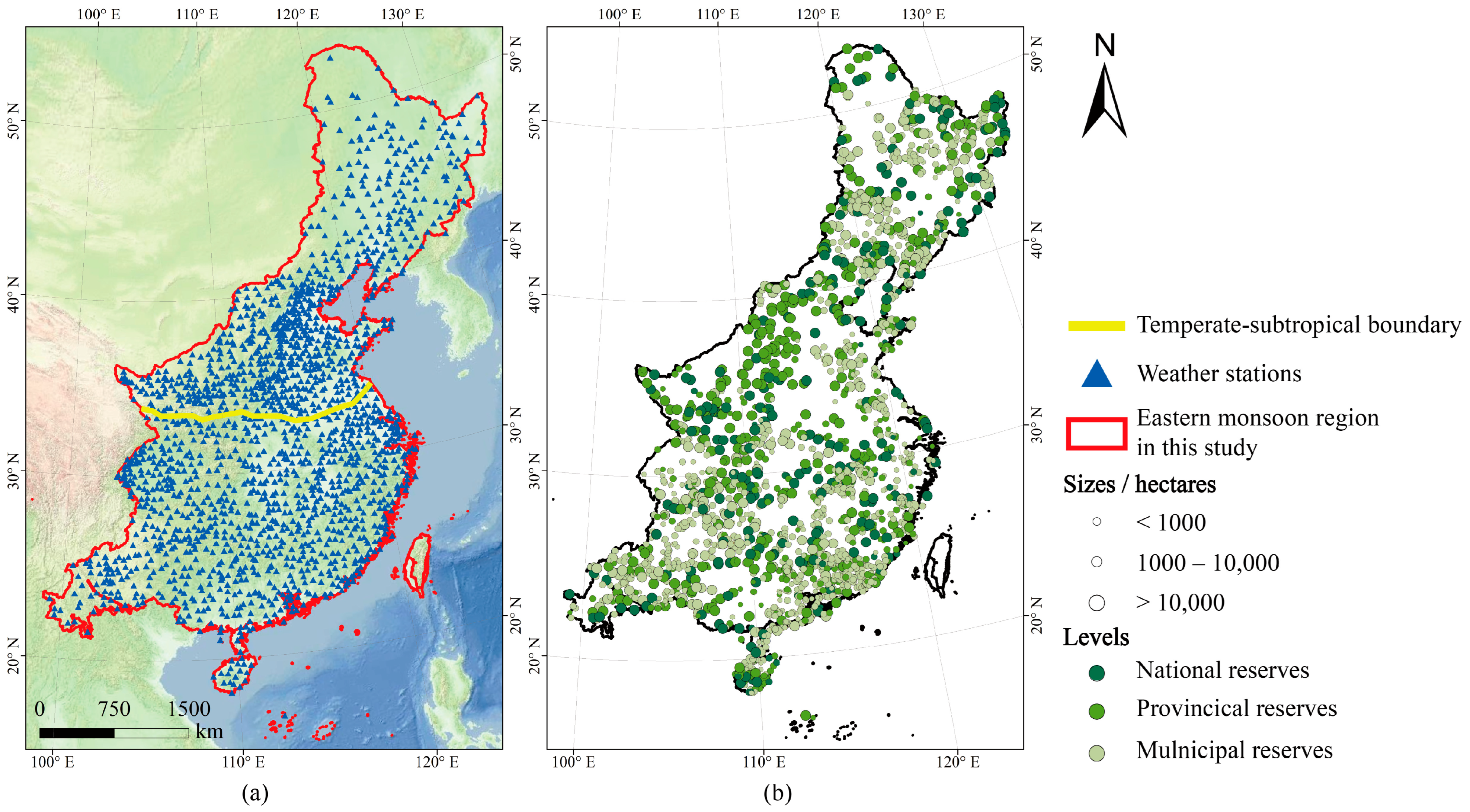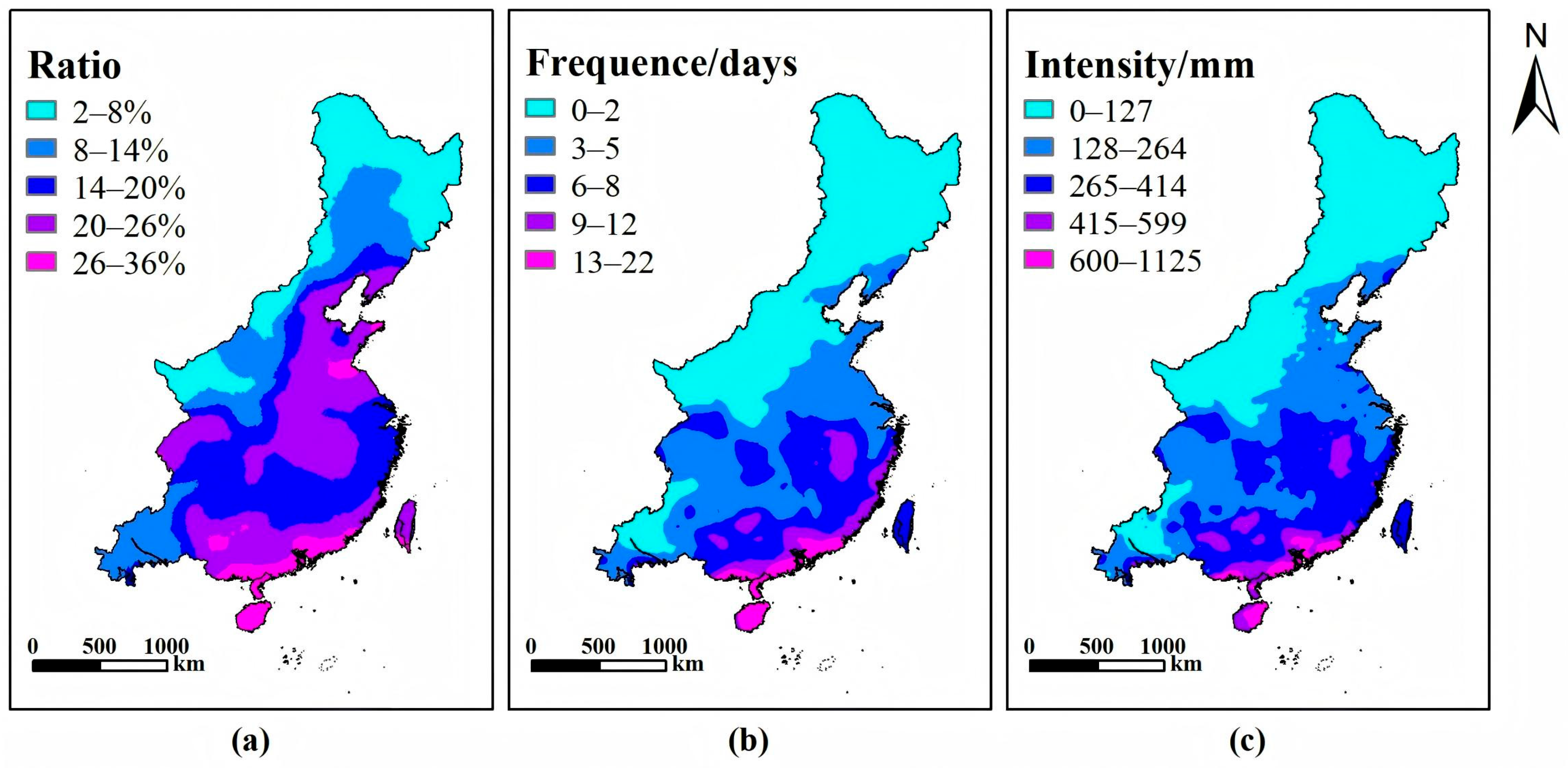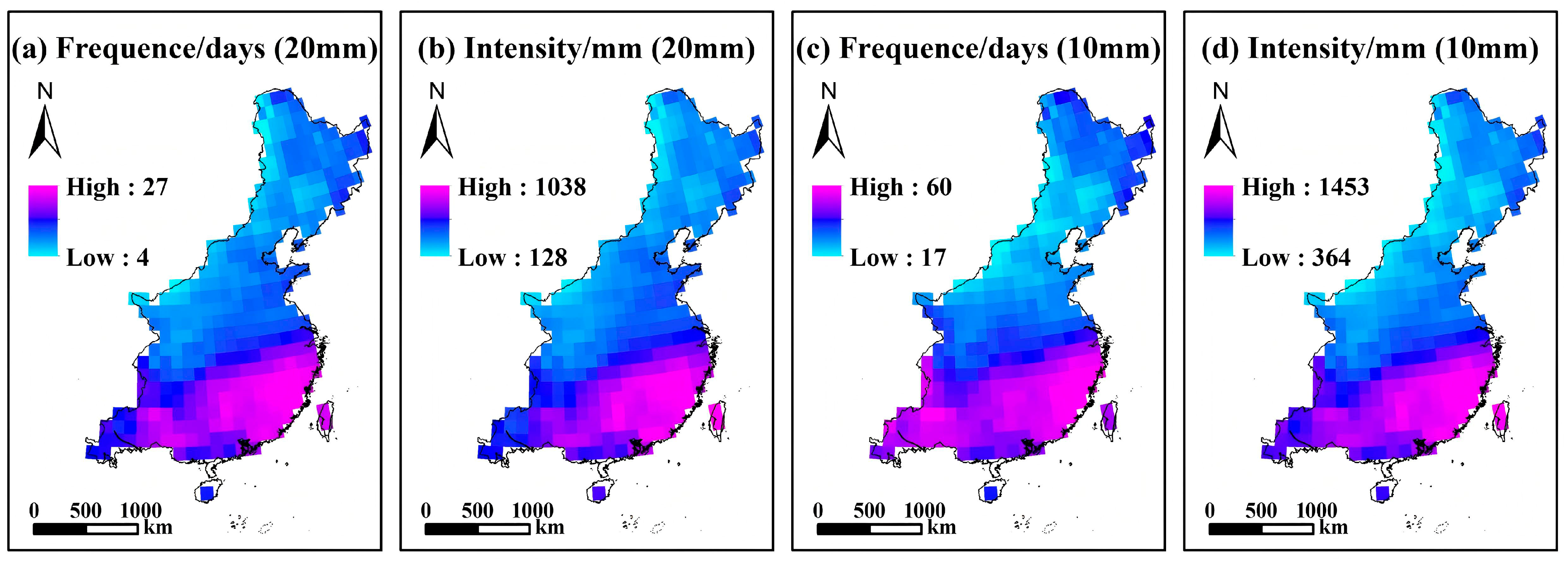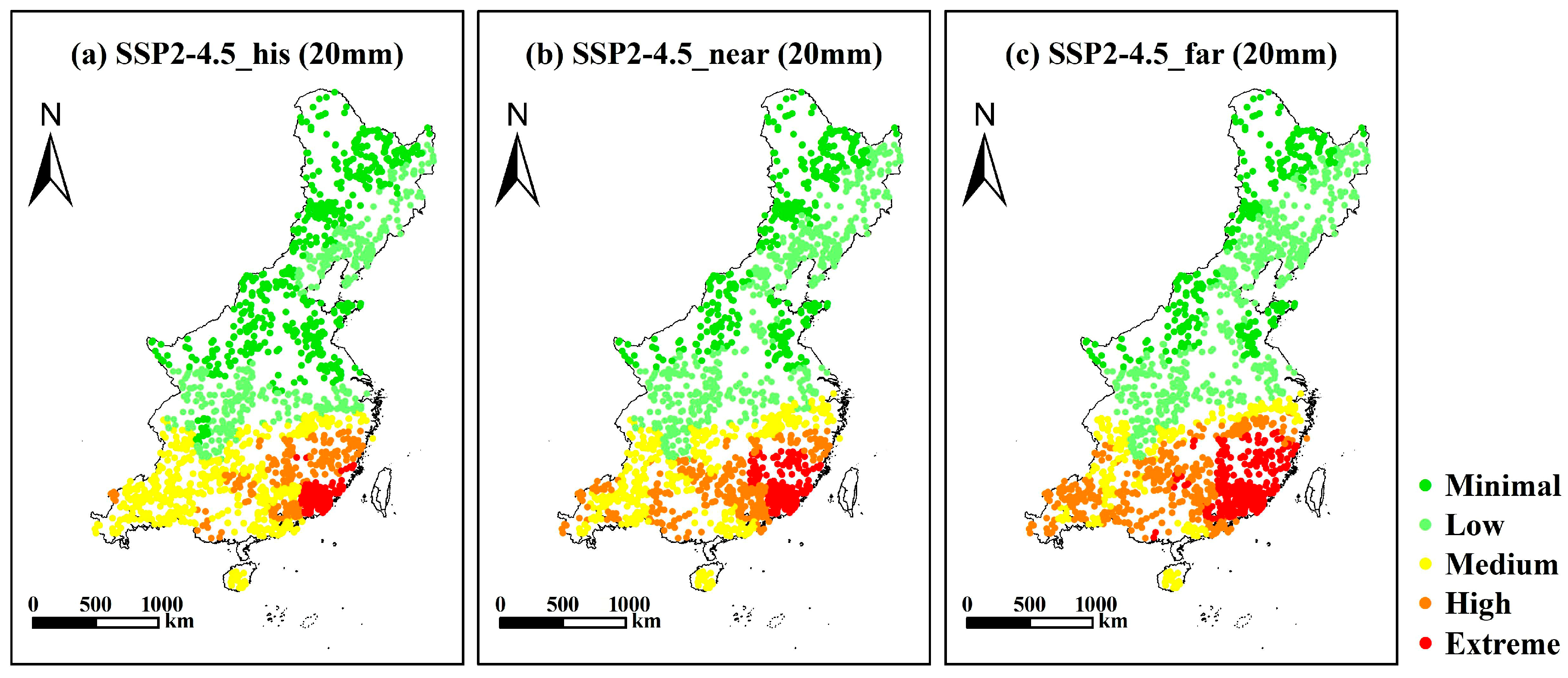Increased Exposure Risk of Natural Reserves to Rainstorm in the Eastern Monsoon Region of China
Abstract
1. Introduction
2. Materials and Methods
2.1. Study Area
2.2. Data
| Data Name | Time Span | Spatial Resolution | Time Resolution | Source |
|---|---|---|---|---|
| Precipitation Data | 1971–2020 | Meteorological Station | Daily | China Meteorological Administration |
| ACCESS-CM2 | 2015–2100 | 1.25° × 1.25° | Earth System Grid Federation [26] | |
| ACCESS-ESM1-5 | 1.25° × 1.25° | Earth System Grid Federation [27] | ||
| BCC-CSM2-MR | 1.125° × 1.125° | Earth System Grid Federation [28] | ||
| EC-EARTH3-VEG | 0.25° × 0.25° | Earth System Grid Federation [29] | ||
| GFDL-ESM4 | 1° × 1° | Earth System Grid Federation [30] | ||
| MIROC6 | 1.4° × 1.4° | Earth System Grid Federation [31] | ||
| MPI-ESM1-2-HR | 0.5° × 0.5° | Earth System Grid Federation [32] | ||
| MPI-ESM1-2-LR | 1.9° × 1.9° | Earth System Grid Federation [33] |
2.3. Methodology
2.3.1. Overview
2.3.2. Interpolation Calculation
2.3.3. Heavy Rainfall Risk Calculation and Exposure Risk Calculation
2.3.4. Entropy Weight Method
2.3.5. Z-Score Standardization
3. Result
3.1. Spatiotemporal Characteristics of Heavy Rainfall in China’s Eastern Monsoon Region
3.2. Exposure Risk of Natural Reserves to Heavy Rainfall in China’s Eastern Monsoon Region
4. Discussion
4.1. The Methodology for Constructing a Rainstorm Exposure Risk Assessment System
4.2. Consistency Between the Evaluation Results of Medium-High Risk Areas and Actual Conditions
5. Conclusions
Author Contributions
Funding
Institutional Review Board Statement
Informed Consent Statement
Data Availability Statement
Conflicts of Interest
References
- Myhre, G.; Alterskjær, K.; Stjern, C.W.; Hodnebrog, Ø.; Marelle, L.; Samset, B.H.; Sillmann, J.; Schaller, N.; Fischer, E.; Schulz, M.; et al. Frequency of extreme precipitation increases extensively with event rareness under global warming. Sci. Rep. 2019, 9, 16063. [Google Scholar] [CrossRef]
- Tabari, H. Climate change impact on flood and extreme precipitation increases with water availability. Sci. Rep. 2020, 10, 13768. [Google Scholar] [CrossRef]
- Li, C.; Zwiers, F.; Zhang, X.; Li, G.; Sun, Y.; Wehner, M. Changes in annual extremes of daily temperature and precipitation in CMIP6 models. J. Clim. 2021, 34, 3441–3460. [Google Scholar] [CrossRef]
- Pawson, S.M.; Brin, A.; Brockerhoff, E.G.; Lamb, D.; Payn, T.W.; Paquette, A.; Parrotta, J. Plantation forests, climate change and biodiversity. Biodivers. Conserv. 2013, 22, 1203–1227. [Google Scholar] [CrossRef]
- Wan, X.; Jiang, G.; Yan, C.; He, F.; Wen, R.; Gu, J.; Li, X.; Ma, J.; Stenseth, N.C.; Zhang, Z. Historical records reveal the distinctive associations of human disturbance and extreme climate change with local extinction of mammals. Proc. Natl. Acad. Sci. USA 2019, 116, 19001–19008. [Google Scholar] [CrossRef] [PubMed]
- Yuan, R.; Zhang, N.; Zhang, Q. The impact of habitat loss and fragmentation on biodiversity in global protected areas. Sci. Total Environ. 2024, 931, 173004. [Google Scholar] [CrossRef] [PubMed]
- Bartzke, G.S.; Ogutu, J.O.; Mukhopadhyay, S.; Mtui, D.; Dublin, H.T.; Piepho, H.-P. Rainfall trends and variation in the Maasai Mara ecosystem and their implications for animal population and biodiversity dynamics. PLoS ONE 2018, 13, e0202814. [Google Scholar] [CrossRef]
- Kramer, K.; Vreugdenhil, S.J.; Van Der Werf, D. Effects of flooding on the recruitment, damage and mortality of riparian tree species: A field and simulation study on the Rhine floodplain. For. Ecol. Manag. 2008, 255, 3893–3903. [Google Scholar] [CrossRef]
- Vretare, V.; Weisner, S.E.; Strand, J.A.; Granéli, W. Phenotypic plasticity in Phragmites australis as a functional response to water depth. Aquat. Bot. 2001, 69, 127–145. [Google Scholar] [CrossRef]
- Asaeda, T.; Hung, L.Q. Internal heterogeneity of ramet and flower densities of Typha angustifolia near the boundary of the stand. Wetl. Ecol. Manag. 2007, 15, 155–164. [Google Scholar] [CrossRef]
- Wen, C.; Gu, L.; Wang, H.; Lv, Z.; Hu, R.; Zhong, J. GAP analysis on national nature reserves in China based on the distribution of endangered species. Biodivers. Sci. 2015, 23, 591–600. [Google Scholar] [CrossRef]
- Shrestha, N.; Xu, X.; Meng, J.; Wang, Z. Vulnerabilities of protected lands in the face of climate and human footprint changes. Nat. Commun. 2021, 12, 1632. [Google Scholar] [CrossRef]
- Wang, Y.; Zhou, L. Observed trends in extreme precipitation events in China during 1961–2001 and the associated changes in large-scale circulation. Geophys. Res. Lett. 2005, 32. [Google Scholar] [CrossRef]
- Dong, C.; Noyelle, R.; Messori, G.; Gualandi, A.; Fery, L.; Yiou, P.; Vrac, M.; D’andrea, F.; Camargo, S.J.; Coppola, E.; et al. Indo-Pacific regional extremes aggravated by changes in tropical weather patterns. Nat. Geosci. 2024, 17, 979–986. [Google Scholar] [CrossRef]
- Duan, Y.; Wu, P.; Chen, X.; Ma, Z. Assessing Global Warming Induced Changes in Summer Rainfall Variability over Eastern China Using the Latest Hadley Centre Climate Model HadGEM3-GC2. Adv. Atmos. Sci. 2018, 35, 1077–1093. [Google Scholar] [CrossRef]
- Hoekstra, J.M.; Boucher, T.M.; Ricketts, T.H.; Roberts, C. Confronting a biome crisis: Global disparities of habitat loss and protection. Ecol. Lett. 2005, 8, 23–29. [Google Scholar] [CrossRef]
- Geldmann, J.; Joppa, L.N.; Burgess, N.D. Mapping Change in Human Pressure Globally on Land and within Protected Areas. Conserv. Biol. 2014, 28, 1604–1616. [Google Scholar] [CrossRef]
- Lewis, E.; MacSharry, B.; Juffe-Bignoli, D.; Harris, N.; Burrows, G.; Kingston, N.; Burgess, N.D. Dynamics in the global protected-area estate since 2004. Conserv. Biol. 2019, 33, 570–579. [Google Scholar] [CrossRef]
- Gray, C.L.; Hill, S.L.L.; Newbold, T.; Hudson, L.N.; Borger, L.; Contu, S.; Hoskins, A.J.; Ferrier, S.; Purvis, A.; Scharlemann, J.P.W. Local biodiversity is higher inside than outside terrestrial protected areas worldwide. Nat. Commun. 2016, 7, 12306. [Google Scholar] [CrossRef]
- Wang, W.; Feng, C.; Liu, F.; Li, J. Biodiversity conservation in China: A review of recent studies and practices. Environ. Sci. Ecotechnology 2020, 2, 100025. [Google Scholar] [CrossRef]
- Xu, B.; Wu, X. A comprehensive analysis to optimizing national-scale protected area systems under climate change. J. Environ. Manag. 2024, 363, 121408. [Google Scholar] [CrossRef]
- Liu, M.; Yuan, H.; Zhou, S. Influence of Climate Change on Wolong Nature Reserve. For. Sci. Technol. 2022, 8, 79–82. [Google Scholar] [CrossRef]
- Wu, X.; Wang, L.; Niu, Z.; Jiang, W.; Cao, Q. More extreme precipitation over the Yangtze River Basin, China: Insights from historical and projected perspectives. Atmos. Res. 2023, 292, 106883. [Google Scholar] [CrossRef]
- Tian, J.; Zhang, Z.; Ahmed, Z.; Zhang, L.; Su, B.; Tao, H.; Jiang, T. Projections of precipitation over China based on CMIP6 models. Stoch. Environ. Res. Risk Assess. 2021, 35, 831–848. [Google Scholar] [CrossRef]
- Zhao, W.; Zong, L.; Wang, M. Spatial distribution of nature reserves in China. Acta Ecol. Sin. 2024, 44, 2786–2799. [Google Scholar] [CrossRef]
- Bi, D.; Dix, M.; Marsland, S.; O’farrell, S.; Sullivan, A.; Bodman, R.; Law, R.; Harman, I.; Srbinovsky, J.; Rashid, H.A. Configuration and spin-up of ACCESS-CM2, the new generation Australian community climate and earth system simulator coupled model. J. South. Hemisph. Earth Syst. Sci. 2020, 70, 225–251. [Google Scholar] [CrossRef]
- Ziehn, T.; Chamberlain, M.A.; Law, R.M.; Lenton, A.; Bodman, R.W.; Dix, M.; Stevens, L.; Wang, Y.-P.; Srbinovsky, J. The Australian earth system model: ACCESS-ESM1. 5. J. South. Hemisph. Earth Syst. Sci. 2020, 70, 193–214. [Google Scholar] [CrossRef]
- Wu, T.; Lu, Y.; Fang, Y.; Xin, X.; Li, L.; Li, W.; Jie, W.; Zhang, J.; Liu, Y.; Zhang, L.; et al. The Beijing climate center climate system model (BCC-CSM): The main progress from CMIP5 to CMIP6. Geosci. Model. Dev. 2019, 12, 1573–1600. [Google Scholar] [CrossRef]
- Döscher, R.; Acosta, M.; Alessandri, A.; Anthoni, P.; Arneth, A.; Arsouze, T.; Bergmann, T.; Bernadello, R.; Bousetta, S.; Caron, L.-P. The EC-earth3 Earth system model for the climate model intercomparison project 6. Geosci. Model. Dev. Discuss. 2021, 2021, 1–90. [Google Scholar]
- Dunne, J.P.; Horowitz, L.; Adcroft, A.; Ginoux, P.; Held, I.; John, J.; Krasting, J.P.; Malyshev, S.; Naik, V.; Paulot, F.; et al. The GFDL Earth System Model version 4.1 (GFDL-ESM 4.1): Overall coupled model description and simulation characteristics. J. Adv. Model. Earth Syst. 2020, 12, e2019MS002015. [Google Scholar] [CrossRef]
- Tatebe, H.; Ogura, T.; Nitta, T.; Komuro, Y.; Ogochi, K.; Takemura, T.; Sudo, K.; Sekiguchi, M.; Abe, M.; Saito, F.; et al. Description and basic evaluation of simulated mean state, internal variability, and climate sensitivity in MIROC6. Geosci. Model. Dev. 2019, 12, 2727–2765. [Google Scholar] [CrossRef]
- Müller, W.A.; Jungclaus, J.H.; Mauritsen, T.; Baehr, J.; Bittner, M.; Budich, R.; Bunzel, F.; Esch, M.; Ghosh, R.; Haak, H. A higher-resolution version of the max planck institute earth system model (MPI-ESM1. 2-HR). J. Adv. Model. Earth Syst. 2018, 10, 1383–1413. [Google Scholar] [CrossRef]
- Mauritsen, T.; Bader, J.; Becker, T.; Behrens, J.; Bittner, M.; Brokopf, R.; Brovkin, V.; Claussen, M.; Crueger, T.; Esch, M. Developments in the MPI-M Earth System Model version 1.2 (MPI-ESM1. 2) and its response to increasing CO2. J. Adv. Model. Earth Syst. 2019, 11, 998–1038. [Google Scholar] [CrossRef]
- Donat, M.; Alexander, L.V.; Yang, H.; Durre, I.; Vose, R.; Dunn, R.J.; Willett, K.M.; Aguilar, E.; Brunet, M.; Caesar, J.; et al. Updated analyses of temperature and precipitation extreme indices since the beginning of the twentieth century: The HadEX2 dataset. J. Geophys. Res. Atmos. 2013, 118, 2098–2118. [Google Scholar] [CrossRef]
- Zhang, B.; Song, S.; Wang, H.; Guo, T.; Ding, Y. Evaluation of the performance of CMIP6 models in simulating extreme precipitation and its projected changes in global climate regions. Nat. Hazards 2025, 121, 1737–1763. [Google Scholar] [CrossRef]
- Krige, D.G. A Statistical Approach to Some Mine Valuation and Allied Problems on the Witwatersrand. J. Chem. Metall. Min. Soc. S. Afr. 1951, 5, 6. [Google Scholar]
- Chen, D.L.; Ou, T.H.; Gong, L.B.; Xu, C.Y.; Li, W.J.; Ho, C.H.; Qian, W.H. Spatial Interpolation of Daily Precipitation in China: 1951–2005. Adv. Atmos. Sci. 2010, 27, 1221–1232. [Google Scholar] [CrossRef]
- Ma, Z.; Li, W.; Peng, J. Application of Entropy Weight Theory in Evaluation of Rainstorm Risk. In Proceedings of the 2017 International Conference on Applied Mathematics, Modelling and Statistics Application (AMMSA 2017); Atlantis Press: Dordrecht, The Netherlands, 2017; pp. 286–289. [Google Scholar]
- Yao, S.; Zhong, S. Exposure Assessment of Rainstorm Disaster Based on Land Use and Precipitation Extreme: A Case Study of Beijing, China. In Proceedings of the ISCRAM 2015 Conference Proceedings—12th International Conference on Information Systems for Crisis Response and Management, Kristiansand, Norway, 24–27 May 2015. [Google Scholar]
- Li, Y.; Zhao, S.-S. Floods losses and hazards in China from 2001 to 2020. Clim. Change Res. 2022, 18, 154–165. [Google Scholar] [CrossRef]
- Hu, J.; Dong, S.; Leibin, W.; Li, W.; Li, Q. Impact of Human Activities on Seasonal Changes in Precipitation in China. Clim. Environ. Res. 2024, 29, 643–655. [Google Scholar] [CrossRef]
- Dong, T.Y.; Dong, W.J. Evaluation of extreme precipitation over Asia in CMIP6 models. Clim. Dyn. 2021, 57, 1751–1769. [Google Scholar] [CrossRef]
- Zhang, T. A rare animal breeding experimental base was established on Daman Island. Chin. J. Wildl. 1985, 2, 49. [Google Scholar] [CrossRef]
- Daily, N.M. Jiangmen Taishan Shangchuan Island Suffered Heavy Rainfall and “Flooded Streets”, Residents Said They Have Long been Accustomed to It. Available online: https://static.nfapp.southcn.com/apptpl/videoToShare/index.html?id=3561372#/ (accessed on 26 August 2025).
- Zheng, W.; Huang, X.; Xu, B. Analysis on the Characteristics and Impact of Meteorological Disasters in Jiangmen City. Available online: https://kns.cnki.net/kcms2/article/abstract?v=YvzTZTPVeK7a4rPRUgjOGHeDZJsTKysstkeNLrDwRn7Z-J8XfbpnIajmGczLszBCHQ4t6eaebXoOoGP07BflZaS3FVwk55lKPGbjgHyCyRjw2sY-HxRyj6V1injhf4hwmqIWF2PfGPHxr5nm313oEGsFQUIApAZMo5_FvjYwFLOSWHsDwF9oRdIo0UVxyp7hnPWeoMb1gNk=&uniplatform=NZKPT&language=CHS (accessed on 26 August 2025).
- Yang, X.; Gao, D.; Wang, P. Characteristics of Temperature and Precipitation Changes in Wumeng Mountain Natural Reserve in 57 Years. IOP Conf. Ser. Earth Environ. Sci. 2019, 237, 022013. [Google Scholar] [CrossRef]
- Wang, P.; Cheng, Q.; Jin, H. Divergent vegetation variation and the response to extreme climate events in the National Nature Reserves in Southwest China, 1961–2019. Ecol. Indic. 2023, 150, 110247. [Google Scholar] [CrossRef]







Disclaimer/Publisher’s Note: The statements, opinions and data contained in all publications are solely those of the individual author(s) and contributor(s) and not of MDPI and/or the editor(s). MDPI and/or the editor(s) disclaim responsibility for any injury to people or property resulting from any ideas, methods, instructions or products referred to in the content. |
© 2025 by the authors. Licensee MDPI, Basel, Switzerland. This article is an open access article distributed under the terms and conditions of the Creative Commons Attribution (CC BY) license (https://creativecommons.org/licenses/by/4.0/).
Share and Cite
Zhou, Y.; Cao, H.; Zhao, L.; Sun, S. Increased Exposure Risk of Natural Reserves to Rainstorm in the Eastern Monsoon Region of China. Atmosphere 2025, 16, 1096. https://doi.org/10.3390/atmos16091096
Zhou Y, Cao H, Zhao L, Sun S. Increased Exposure Risk of Natural Reserves to Rainstorm in the Eastern Monsoon Region of China. Atmosphere. 2025; 16(9):1096. https://doi.org/10.3390/atmos16091096
Chicago/Turabian StyleZhou, Yixuan, Hanming Cao, Lin Zhao, and Shao Sun. 2025. "Increased Exposure Risk of Natural Reserves to Rainstorm in the Eastern Monsoon Region of China" Atmosphere 16, no. 9: 1096. https://doi.org/10.3390/atmos16091096
APA StyleZhou, Y., Cao, H., Zhao, L., & Sun, S. (2025). Increased Exposure Risk of Natural Reserves to Rainstorm in the Eastern Monsoon Region of China. Atmosphere, 16(9), 1096. https://doi.org/10.3390/atmos16091096








